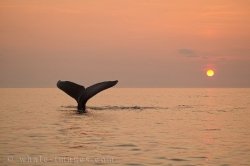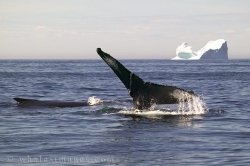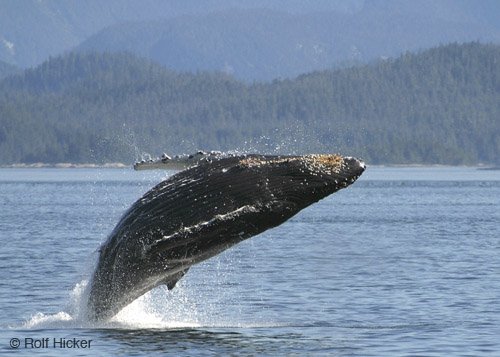Humpback Whale Facts Information
Facts, information and pictures about Humpback Whales.
Path: Animal Facts / Humpback Whale Facts & Information
-
Humpback Whales
- Scientific Name: Megaptera novaeangliae
- Family: Baleen Whale
- Class: Marine Mammal
Humpback Whale Facts: GENERAL Information:
Humpback Whales (please check out our humpback whale pictures) are mammals belonging to the baleen whale suborder and can be found in oceans and seas around the world. They are well known for breaching, and their complex songs. The name humpback whale describes the motion it makes as it arches its back out of the water in preparation for a dive.
Humpback Whale Facts: PHYSICAL CHARACTERISTICS:
Humpback Whale can be easily identified by their stocky body with obvious humps and black upper parts. The head and lower jaw are covered with small, round bumps on the front of the head called knobs or tubercles, and are characteristic of the species.
The Humpback whale breathe air at the surface of the water through 2 blowholes located near the top of the head. Their blow is a double stream of spray that rises 10-13 feet (3.1-4 m) above the surface of the water. The tail flukes of a humpback whale, which are lifted high in the dive sequence, have wavy rear edges. The deeply-notched flukes (tail) are up to 12 feet (3.7 m) wide. An adult usually ranges between 12-16 m long and weighs approximately 36 tonnes.
The pectoral fins, which are up to one-third of a Humpback Whale body length, have rough edges are the largest flippers of any whale. Humpback Whale have a small stubby dorsal fin toward the flukes. Humpback whale have 14-35 throat grooves that run from the chin to the navel. These grooves allow their throat to expand during the huge intake of water during filter feeding.
The female Humpback Whale typically breed every two or three years. The gestation period is eleven months, yet some individuals can breed in two consecutive years. A Humpback Whale calf is about 4–- 4.5 metres long when born and weighs approximately 700 kg. Calves are nursed by their mothers for their first six months, then are sustained through a mixture of nursing and independent feeding for a further six months. Calves leave their mothers at the start of their second year, when they are typically 9 metres long.
Both males and females reach sexual maturity around the age of five. Full adult maturity is achieved at around 15 years. Grown size is commonly 15–-16 metres in males, 16–-17 metres in females, and a weight of 40,000 kg; the largest ever recorded specimen was 19 metres long and had pectoral fins measuring six metres each. A Humpback Whale can live for 45–- 50 years.
Humpback Whale Facts: DIET AND TEETH:
Humpback whale (like all baleen whales) are seasonal feeders and carnivores that filter feed tiny crustaceans, plankton, and small fish (including herring, mackerel, capelin, and sandeel) from the water. They are gulpers (not skimmers), filter feeders that alternatively swim then gulp a mouthful of plankton or fish. Concentrated masses of prey are preferable for this method of feeding. An average-sized humpback whale will eat 4,400-5,500 pounds (2000-2500 kg) of plankton, krill and small schooling fish each day during the feeding season in cold waters (about 120 days). They eat twice a day.
Its most inventive feeding technique is called bubble net fishing. A group of Humpback whales swim rapidly in wide circles around and under a school of fish, blowing air through their blowholes. The bubbles form a visual barrier that serves to confine the school within an ever tighter area. One humpback whale or more then suddenly swim upwards and through the bubble net, mouths agape, swallowing thousands of fish in one gulp. This technique can involve a ring of bubbles up to 30 metres in diameter and the cooperation of a dozen animals at once. It is perhaps the most spectacular act of cooperation among marine mammals.
Humpback Whale Facts: SOCIAL STRUCTURE & COURTSHIP:
The Humpback Whale social structure is loose-knit. Usually, individuals live alone or in transient small groups that come together and break up over the course of a few hours. Humpback Whale Groups may stay together a little longer in summer in order to forage and feed co-operatively. More long-term relationships between pairs and small groups, lasting months or even years, have been observed, but are rare. The range of the Humpback Whale overlaps considerably with many other whale and dolphin species —- but whilst it may be seen in the vicinity of other species (for instance, the Minke Whale), it rarely interacts socially with them.
Courtship rituals take place during the winter months. Competition for a mate is usually fierce. Groups of males of two to twenty in number typically gather around a single female and exhibit a variety of behaviours in order to establish dominance. The displays last several hours and the group size may ebb and flow in number as unsuccessful males retreat and others arrive to try their luck. Techniques used include breaching, spy-hopping, lob-tailing, tail-slapping, flipper-slapping, charging and parrying.




Keywords
- page
- Animal Facts (9)



